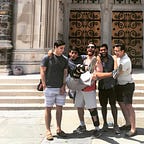The Science of Split-Brain
What happens when the connection between the two halves of your brain is cut?
7–19–16, Adil
So, back in the day when people had really bad seizures, surgeons figured out they could really help the epilepsy by cutting the corpus callosum — the huge bundle of white matter nerve fibers that connects the left and right hemispheres of the brain. Seizures stopped!
So, at this point, your left and right hemispheres are no longer connected. This leads to some spooky effects, mainly stemming from the the fact that language is localized to the left hemisphere.
Remember, normally your left brain controls your right body and your right brain controls your left body. In a normal person, this language lateralization to the left side doesn’t matter because the both hemispheres talk to each other via the corpus callosum. BUT, in a split-brain patient, this communication can’t happen. Let’s look at some examples.
If you show a split-brain patient a word in their right visual field, it goes to their left hemisphere (just like it does for a normal person). Because the left brain is also responsible for speaking, the person can vocalize the word you showed them.
But, if you show a split-brain patient a word in their left visual field, it goes to their right hemisphere (again just like normal), but they cannot vocalize the word. This is because the language center is on the left side of the brain; the right side can’t vocalize anything on its own. So, when you show them a word in their left visual field, the person will say “I didn’t see anything.”
BUT it gets better. Again, say you showed him a word in his left visual field, i.e. right brain. He cannot vocalize the word. But, if you ask him to draw what he saw using his left hand, he IS capable of drawing it! This is because the right brain controls the left hand. Though the right brain cannot vocalize the word, it still controls the left hand, and it can draw. After he draws the picture, he can identify it, and then extrapolate what the word must have been. Pretty cool.
BUT, even cooler: say you show one picture in the left visual field and one picture in the right visual field at the same time. You ask him, “what was the picture?” and he’ll only tell you the picture in the right visual field (i.e. the side corresponding to left brain, which controls language). But, then you ask him to draw that picture with his left hand, he actually draws what was in the left visual field! When you ask him why he drew that, he doesn’t know.
A lot of times, instead of saying “I don’t know”, people’s left hemispheres actually make up stories to try and rationalize things. New example: say you show someone’s right hemisphere (left visual field) a picture of a snowy day and ask them to pick out a corresponding tool with their left hand. Instead of choosing a rake or pickaxe, they logically choose a shovel to shovel snow. Simultaneously, you show a picture to left hemisphere (right visual field) of a chicken foot and ask them to pick the corresponding picture with their right hand; correctly, the person selects the picture of chicken’s head.
BUT, when you ask him why his left hand chose a shovel, he has no idea. His right brain was the one that made the choice for shovel, but his left brain has no idea this happened and thus he can’t vocalize the correct reply. Instead of saying “I don’t know”, though, he actually makes up a lie: “Because you use a shovel to clean the chicken coop.” This is a classic example of our brain trying to fill in missing pieces where we don’t know things.
Lots of other cool side effects too, but this is already long enough. To see famous examples of this in a real person, skip to 1:20 in this video. And here’s the chicken/snow example with a picture.
